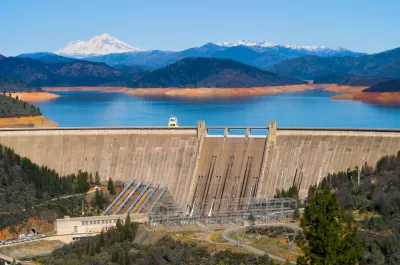The state is slowly starting to curb water consumption, but progress has been ‘disappointingly slow’ as water supplies across the West diminish to historic lows.

Californians are saving more water, but it’s still not enough to meet Governor Newsom’s goal of reducing water use by 15 percent, reports Hayley Smith in the Los Angeles Times. “After months of middling efforts — including a 17.6% increase in urban water use in April — residents in May saved 3.1% more water than in the same month in 2020, the baseline year against which current data are measured, according to new figures from the State Water Resources Control Board.”
Since April, “The latest figures indicate the message is seeping in, albeit only slightly, with the South Coast hydrologic region that is home to Los Angeles eking out a 2.2% savings in May.” According to Peter Gleick, co-founder and senior fellow of the Pacific Institute, “It’s progress in the right direction, but it’s still disappointingly slow.” The article indicates that Californians only cut water use by 2 percent since last July.
“On June 10, the water board required all urban water suppliers to implement Level 2 of their emergency drought restrictions. It also took the step of banning the irrigation of “nonfunctional grass,” or grass that is purely decorative, at businesses and in common areas of subdivisions and property controlled by homeowner associations.” The decision comes as the state’s largest reservoir, Lake Shasta, sits at 39 percent of capacity, “about half its average for this time of year.”
Smith writes that “The [2022-2023 state budget] allocates $2.8 billion for drought response and water resilience, officials said, including $175 million for water-saving strategies such as turf replacement.” According to a separate article in WaterWorld, the California Department of Water Resources (DWR) just awarded $2 million to four water conservation projects aimed at improving drought resilience.
FULL STORY: California is finally reducing water use, but it’s not enough amid severe drought

Alabama: Trump Terminates Settlements for Black Communities Harmed By Raw Sewage
Trump deemed the landmark civil rights agreement “illegal DEI and environmental justice policy.”

Study: Maui’s Plan to Convert Vacation Rentals to Long-Term Housing Could Cause Nearly $1 Billion Economic Loss
The plan would reduce visitor accommodation by 25% resulting in 1,900 jobs lost.

Why Should We Subsidize Public Transportation?
Many public transit agencies face financial stress due to rising costs, declining fare revenue, and declining subsidies. Transit advocates must provide a strong business case for increasing public transit funding.

Paris Bike Boom Leads to Steep Drop in Air Pollution
The French city’s air quality has improved dramatically in the past 20 years, coinciding with a growth in cycling.

Why Housing Costs More to Build in California Than in Texas
Hard costs like labor and materials combined with ‘soft’ costs such as permitting make building in the San Francisco Bay Area almost three times as costly as in Texas cities.

San Diego County Sees a Rise in Urban Coyotes
San Diego County experiences a rise in urban coyotes, as sightings become prevalent throughout its urban neighbourhoods and surrounding areas.
Urban Design for Planners 1: Software Tools
This six-course series explores essential urban design concepts using open source software and equips planners with the tools they need to participate fully in the urban design process.
Planning for Universal Design
Learn the tools for implementing Universal Design in planning regulations.
Smith Gee Studio
Alamo Area Metropolitan Planning Organization
City of Santa Clarita
Institute for Housing and Urban Development Studies (IHS)
City of Grandview
Harvard GSD Executive Education
Toledo-Lucas County Plan Commissions
Salt Lake City
NYU Wagner Graduate School of Public Service





























